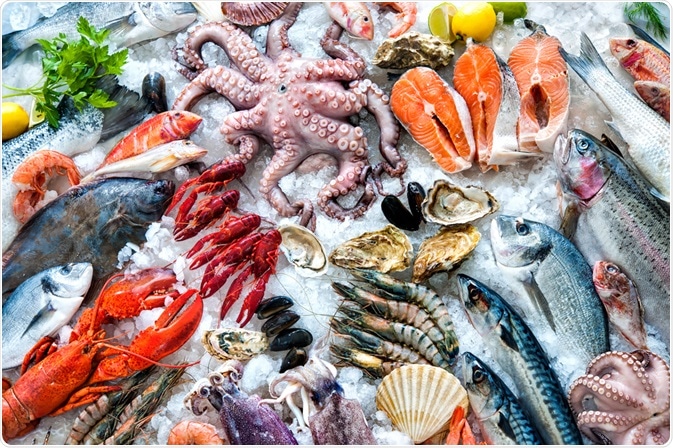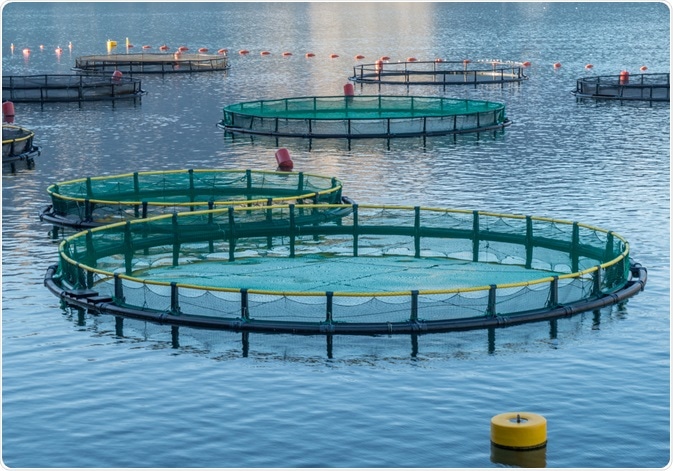In the US, around half of all food produce ends up being thrown away. As the global population grows, the demand for food rises and available land for farming reduces, agencies worldwide are striving to tackle the food crisis and make more food available to the expanding population.

Image Credit: Alexander Raths/Shutterstock.com
The shelf-life of food plays a major role in food waste, as products with a shorter shelf-life are more likely to end up being wasted due to not being consumed in time.
Seafood is one food group that typically has a short shelf-life. Methods that extend the shelf-life of seafood could, therefore, help tackle the food crisis and reduce the volume of food thrown out each year.
Recently, researchers in Ecuador have developed an edible coating that extends the shelf-life of seafood. The innovation will help not only tackle the food crisis, but will also prevent illness from food poisoning, reduce the number of fish being farmed, and indirectly lower the emissions related to the food industry.
The importance of seafood in modern diets
Seafood is of huge dietary importance given its high protein, vitamin, and mineral content, and generally low polyunsaturated fat and calorie content.
A growing body of evidence is demonstrating that the regular consumption of seafood can have the impact of reducing the risk of suffering from several illnesses, such as cardiovascular disease, stroke, hypertension, and even obesity.
However, the food product is particularly perishable due to its high free amino acid content and surface humidity. Seafood is even more perishable than red meat and chicken.
For these reasons the shelf-life of seafood must be extended so that more people can enjoy fish as a part of a healthy diet.
Edible coatings to extend shelf-life
Back in 2016, Food Engineering graduate Ximena Carrión Granda innovated an edible coating developed from natural materials with the capability of extending the shelf-life of seafood by two to four days.
The antimicrobial properties of the coating are key to lengthening the time that fish products can survive by reducing the growth of microorganisms that spoil the food.
The coatings are edible films that are constructed from layers of natural materials that create a barrier, preventing microbes in the atmosphere from being introduced to the food product.
Factors such as humidity and fat oxidation are also prevented from affecting the food product which enhances its quality and extends its shelf-life.
Creating a natural antimicrobial coating
The edible coating is constructed mostly from whey protein isolate, and chitosan, which is a polysaccharide from chitin, the structural component that forms the shells of crustaceans.
Under test conditions, these elements are insoluble in water and colorless. Importantly, different antimicrobial agents build up on the coating over time, preventing microorganisms that add to the deterioration of the food from growing. It is this action that extends the shelf-life of the product.
Also, natural elements that have antimicrobial properties were added to the coating to enhance its antimicrobial action.
Essential oils were extracted from thyme and rosemary, and extracts of plants including garlic, oregano, and sage were also added. Also, L. Plantarum, L. lactis, and W. confusa, lactic acid bacteria, were included in the coating.
To create a coating of the highest antimicrobial properties, the team experimented with different ratios of these additional compounds, testing their level of antimicrobial activity at different concentrations by measuring their impact on a total of 14 different strains of bacteria all related to spoilage of seafood.
The team then selected the best formulations to test on fresh tuna, hake fillets, and peeled shrimp tails. The results demonstrated that the greatest antimicrobial impact was achieved by the combinations that contained the oregano and thyme essential oils, as well as the rosemary extract.
This formula prevented the growth of both pathogenic bacteria and deteriorating bacteria better than other tested combinations.
The formula was then tested on a more extensive range of seafood, with findings revealing that the coating was successful in extending the shelf-life of the products from two to four days.
Since the results were published in 2016, further studies have confirmed the effectiveness of these natural coatings on a range of fish packaged and stored in different ways.
The impact of extending the shelf-life of seafood
Strategies that allow fish to last longer before it perishes will be fundamental in tackling the food crisis as they will reduce food waste, making more food available.
Also, lengthening expiration dates will mean that food poisoning rates may be reduced as people are less likely to consume spoiled seafood products.
When fish such begins to spoil the bacteria that have begun to infiltrate it produces histamines in the fish that can cause a severe allergic-like reaction (in the case of scombrotoxin poisoning, for example). Given that food poisoning affects at least 600 million each year, a strategy that could reduce this even by a small percentage would be significant.
Further to this, the number of fish farmed from the sea will be reduced as an indirect result of less fish being spoiled and thrown out before it is eaten. This is beneficial to conservation and is better for the environment.
Finally, while fish farming produces significantly fewer carbon emissions than the farming of land animals, it still contributes vast amounts of greenhouse gases into the atmosphere each year due to the processes involved in catching, packaging, and transporting the products.
By extending the shelf-life of seafood, emissions are indirectly reduced because fewer fish need to be taken and transported.
In the future, we can expect methods such as edible coatings to become widely adopted so that fish products globally have extended shelf-lives.

Image Credit: Ranko Maras/Shutterstock.com
Sources:
- da Silva Santos, F., da Silva, A., Vieira, C., de Araújo, M., da Silva, A., Carneiro-da-Cunha, M., de Souza, B., and de Souza Bezerra, R., 2017. Use of chitosan coating in increasing the shelf life of liquid smoked Nile tilapia (Oreochromis niloticus) fillet. Journal of Food Science and Technology, 54(5), pp.1304-1311. https://www.ncbi.nlm.nih.gov/pmc/articles/PMC5380640/
- Eating seafood can reduce your carbon footprint, but some fish are better than others. Available at: oceana.org/.../eating-seafood-can-reduce-your-carbon-footprint-some-fish-are-better-others
- Edible coatings able to extend the shelf-life of fish and seafood products. Available at: phys.org/news/2016-04-edible-coatings-shelf-life-fish-seafood.html
- Every year, almost half a million people die from a seemingly harmless illness. Available at: www.businessinsider.com/annual-food-poisoning-deaths-2015-12
- Half of all US food produce is thrown away, new research suggests. Available at: www.theguardian.com/.../us-food-waste-ugly-fruit-vegetables-perfect
- Olatunde, O., and Benjakul, S., 2018. Natural Preservatives for Extending the Shelf-Life of Seafood: A Revisit. Comprehensive Reviews in Food Science and Food Safety, 17(6), pp.1595-1612. https://onlinelibrary.wiley.com/doi/full/10.1111/1541-4337.12390
- Smarter Seafood Storage. Available at: www.thebetterfish.com/.../
Further Reading
Last Updated: Jan 28, 2021